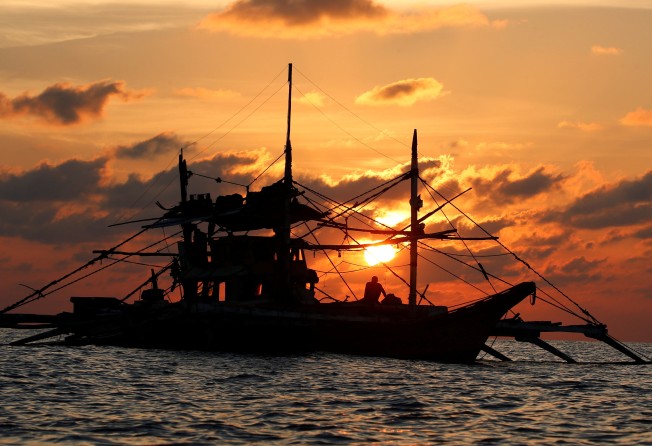Philippine fishermen protest Chinese harvesting of giant clams on Scarborough Shoal in further South China Sea dispute
- The fishermen say Beijing has ignored a previous protest and the activities of Chinese vessels are severely damaging the environment
- Claims come as China insists Chinese vessel’s collision with Filipino boat was an accident and it had not tried to rescue fishermen for fear of being besieged

Beijing has ignored a protest from Manila asking Chinese fishermen to cease harvesting giant clams from the Scarborough Shoal, a group of Filipino fishermen claimed Friday, as bilateral tensions rise anew over the sinking of a Philippine fishing boat by a suspected Chinese trawler.
According to Nards Cuaresman – president of local fishermen in the town of Masinloc in Zambales, a province close to the mineral-rich South China Sea – the so-called Chinese maritime militia is using propellers mounted on small boats to break corals and dig into the 150 sq km lagoon. The clams are later brought aboard a larger vessel.
“They were also using an underwater hammer. They smashed coral reefs just to get the giant clams. If the government will not do something, then in the next two years, all the swathes of coral and the population of giant clam will be gone,” he said.
Despite a diplomatic protest filed by the Philippines earlier this year, Cuaresman said, the Chinese maritime militia continued to collect clams in the shoal, known as Huangyan Island in China and Pantag Shoal in the Philippines.
Moreover, contrary to what the Chinese government says, Cuaresma said local fishermen cannot freely fish in the Scarborough Shoal, citing the Chinese Coast guards who were “always blocking and harassing” them.
“Our small fishing boats can only sneak in if there is bad weather,” he said.
Manila had earlier protested the presence of more than 200 Chinese ships from January to March this year off the Philippine-occupied Pag-asa Island in the South China Sea.
Jay Batongbacal, director of the University of the Philippines’ Institute for Maritime Affairs and Law of the Sea, said the giant clams were seeded in the late 1980s by the Philippines, while the Chinese began harvesting them in 2003.
“We seeded giant clams in that area because this is an endangered species. If the clams are gone, our coral reefs there will not last,” he said, adding that the Chinese were throwing away the meat of the clam and just keeping the shells.
From Scarborough Shoal, the Chinese bring the clam shells to Hainan province, where buyers carve them into figurines.
“It’s a substitute for ivory. Some of them are also used as jewellery materials,” Batongbacal said.
Yolanda Esguerra, national director of environmentalist group Philippine Misereor Partnership Incorporated, said the group was working with some lawmakers to create a Rights of Nature law to protect biodiversity in the disputed waters.
“The government should act on this matter. The diplomatic protest with China is not enough. This covers international law so the negotiation here should include other claimants,” she said.
The fishermen’s claim came as Manila on Thursday issued a diplomatic protest against Beijing after a Filipino fishing boat was sunk by a suspected Chinese vessel at Reed Bank, though neither side has officially confirmed the boat involved in what some call a “hit-and-run” incident was Chinese-registered.

Reed Bank is about 150km off the Philippine island of Palawan. It is within Manila’s 200-nautical-mile exclusive economic zone and far from China’s nearest major land mass.
Chinese foreign ministry spokesman Geng Shuang on Thursday called the incident “an ordinary maritime traffic accident”, and said China was still investigating.
He added, however: “If the relevant reports are true, regardless of the country from which the perpetrator came from, their behaviour should be condemned.”
Geng said it was irresponsible for the Philippines to “politicise the incident without verification”.
Regardless of the nature of the collision … common decency and the dictates of humanity require the immediate saving of the crew of the downed Philippine vessel
The Chinese embassy in Manila later issued a statement denying the incident was a hit-and-run, saying that preliminary investigation showed the Chinese fishing boat had been berthed when it was “suddenly besieged by seven or eight Filipino fishing boats”.
“During evacuation”, the statement said, the vessel failed to avoid a Filipino fishing boat and a steel cable “bumped into the Filipino pilothouse. The Filipino fishing boat tilted and its stern foundered.”
The statement added that the Chinese captain had tried to rescue the Filipino fisherman but was afraid of being besieged by the other Filipino fishing boats and sailed away after confirming the fishermen had been rescued by their compatriots.
Although Philippines President Rodrigo Duterte has largely set aside the bitter dispute with Beijing over the countries’ overlapping claims in the South China Sea, Manila does sometimes protest Chinese action in the disputed waterway.
In an angry statement issued Thursday, Duterte’s spokesman Salvador Panelo blasted the crew of the suspected Chinese trawler, saying “such an act of desertion is as inhuman as it is barbaric”.
“Regardless of the nature of the collision, whether it was accidental or intentional, common decency and the dictates of humanity require the immediate saving of the crew of the downed Philippine vessel,” he said.
Panelo also thanked the crew of a Vietnamese fishing vessel in the vicinity, which he said brought the Filipinos to safety.
Like the Philippines, Vietnam has partial claims over the South China Sea, where Beijing has staked its “indisputable sovereignty” and built artificial islands with military facilities and airstrips. Taiwan, Brunei and Malaysia also have claims in the area.